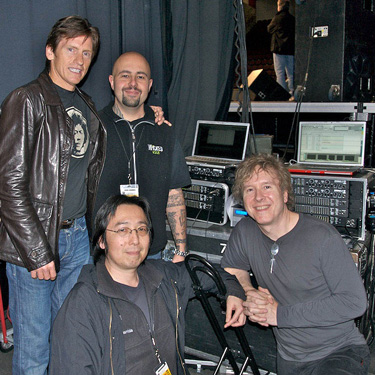|
 Comedian/actor Denis Leary; Metric Halo's consultant/engineer, Allen Rowand; musician/audio engineer, Hiro Honshuku; and Denis Leary's musical director, Charly Roth with the Metric Halo remote recording rig used to record the music at the most recent Comedian/actor Denis Leary; Metric Halo's consultant/engineer, Allen Rowand; musician/audio engineer, Hiro Honshuku; and Denis Leary's musical director, Charly Roth with the Metric Halo remote recording rig used to record the music at the most recent
BOSTON, MASSACHUSETTS: Whether Hiroaki Honshuku is performing as a musician or working as an audio engineer, Metric Halo hardware and software is invariably involved. Recently, Honshuku’s A-NO-NE Studio Services was hired to record the music performed during “Comics Come Home XIII,” a charity event hosted by Denis Leary at Boston University’s Agganis Arena, for which he used a multi-track remote recording rig comprised of two Metric Halo Mobile I/O 2882+DSP and two ULN-2+DSP units, plus an Apple MacBook Pro.
“For this gig I had 28 channels of Metric Halo, but we used only 26,” says Honshuku. “We were killing two birds with one stone. Denis did a few songs, and one of the songs was new and he wanted to record it. His backing band opened the show and also wanted to have a recording.” Leary’s new live recording, “At The Rehab,” will be available through Comedy Central Records in spring 2008.
Leary’s musical director, multi-instrumentalist C.P. ‘Charly’ Roth, is the drummer and vocalist with The CrownRoyals, who opened the show. The four-piece also includes Roth’s brother Adam on guitar and vocals, Chris Phillips on guitar and vocals, and Alec Morton on bass and vocals. “We’re going to be putting that recording out on the CrownRoyals website,” says Charly Roth. “It will be primarily what Hiro recorded. Everything sounded awesome.”
“At The Rehab” was co-written with Leary by Adam Roth and Phillips. The Roth brothers and Phillips have worked with Leary for many years: “We did the ‘No Cure for Cancer’ record and ‘The Asshole Song’ with him, and we did ‘Unplugged’ with him,” says Charly Roth, who is a longtime user of Metric Halo’s ChannelStrip plug-in. “That’s my go-to EQ. When something either really needs to be fixed, or could just sound better, that’s the thing that I grab. I still haven’t heard a high-end off a plug-in that sounds like that. I haven’t heard a high-end like that off most analog boards, either!”
“Comics Come Home,” the longest running comedy benefit in America, also featured performances by Lenny Clarke, Artie Lange, Jim Norton, Joe Yannetty, Mike Birbiglia, Pete Correale and Robert Kelly. The evening was a benefit for The Cam Neely Foundation for Cancer Care and The Neely Cancer Fund.
Allen Rowand, a sound engineer and designer and consultant who recently joined Metric Halo, supplied a backup Mobile I/O rig for the concert. “I’m glad Allen’s system was there for backup, because I had one bad cable,” reveals Honshuku. “A backup is so important; I’m glad he was available for that.”
Honshuku operates all of his endeavors under the A-NO-NE name. The A-NO-NE Band, which performs Honshuku’s compositions, can be a small jazz, avant-garde or funk fusion group, or even a big band, while A-NO-NE Studio Services is both a production studio and a remote recording business. “The room isn’t a commercial studio,” he says. “I am a musician first, and recording is something I do for my musician friends.”
Many of his remote recording projects only require a single ULN-2+DSP unit, Honshuku says. “I only need two channels for most of the classical chamber music that I record in concert halls and churches in Boston.” His other ULN-2+DSP usually resides in his live performance rack: “I play flute and EWI [Electronic Woodwind Instrument]. I just had Joe Buchalter from Metric Halo put Jensen transformers on my performance ULN-2 and the flute sounds so good, so sweet.”
The Mobile I/O units are usually located in the A-NO-NE studio, where Honshuku mixes ‘in the box,’ he shares. Having the units readily available has been useful for more than just mixing: “We were rehearsing for a show and we thought we sounded so good that we should record. So we did and it came out great – that was my last CD. That’s the beauty of the Mobile I/O – put it up, start it up, and just hit record.”
Honshuku has had the good fortune to get his hands on pre-production models of Metric Halo hardware over the years. “They sound amazing. Every time they come up with a new box I have it. I was actually the second person to get a 2882, the year they started making hardware.” So why did he choose Metric Halo? “In addition to it sounding good, the 24/7 support won him over. The designers are involved closely with the users. That’s a big selling point. These guys are geniuses.”
Honshuku is an equally avid fan of Metric Halo’s software, and uses both SpectraFoo and ChannelStrip regularly. “Once you use SpectraFoo, the problem is that you can’t do anything without it. You get spoiled,” he says. ChannelStrip gets used only during the mixing process, he adds. “I wasn’t trained formally, so I don’t want to take a chance with printing something through ChannelStrip. But Metric Halo boxes are so pristine, so you can do whatever you want later, not when you’re tracking. |